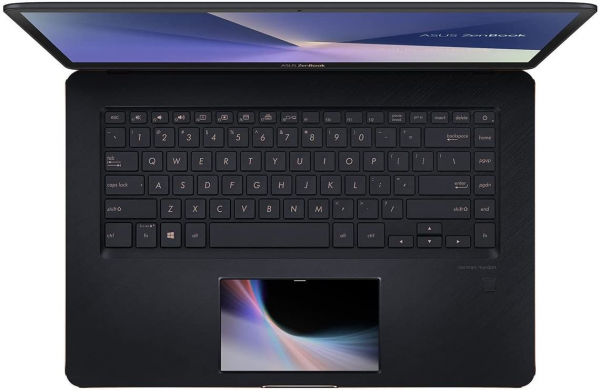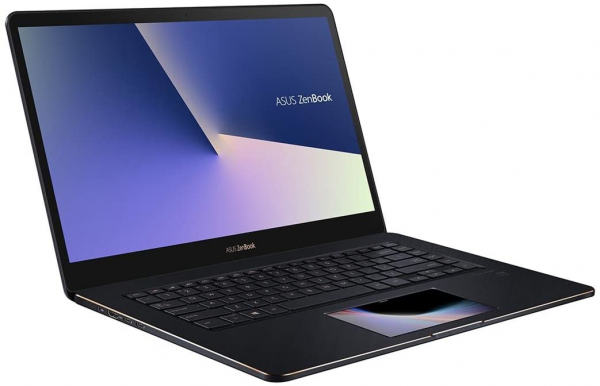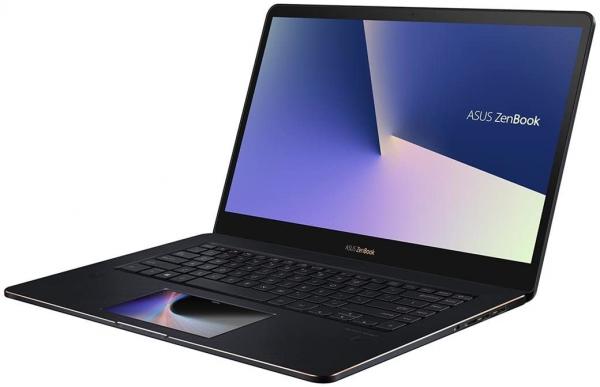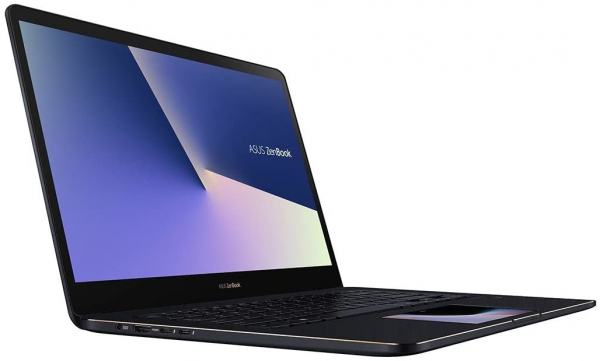Asus
Asus ZenBook Pro Duo: a two-screen laptop with Oled reinforcement
Aprox. 2699€
See specificationsThe ZenBook Pro Duo from Asus arrives in Europe and stands out with a very special feature: it is the first laptop to offer a second screen between the keyboard and the main screen. Simple gadget or real good idea?
Our review
Presentation
The Asus ZenBook Pro Duo is the first laptop on the market to integrate a second screen that works like a second display. Located between the keyboard and the main screen, it seeks above all to seduce image professionals by offering them the comfort of a dual screen configuration when on the move.
In addition to a second screen, this PC mainly has a 15.6-inch Oled touch main screen, a first for this format. The ZenBook Pro Duo benefits from a 9th generation Intel Core i7, but also from an Nvidia GeForce RTX 2060 graphics card. A cocktail that raises the price to more than € 3,000. The price to pay for an exceptional computer, which does not have only its second screen to offer.

Screen
The ZenBook Pro Duo has two screens and is based on this concept. The main screen consists of an Oled panel designed by Samsung of 15.6 inches and a definition of 3480 x 2160 px. Oled panels are rare on laptops, and it is the first model on the market to adopt this technology in this precise format. The screen / facade ratio is high, since it was calculated by us at 86%. The second screen, the ScreenPad Plus, is a classic 14-inch IPS LCD screen with a resolution of 3,840 x 1,100 px. Note that this last screen has an anti-reflective and anti-fingerprint treatment, which visually gives it a very different appearance from the Oled screen and surprises on first use.
Once the Oled screen passed under the lens of our probe, it gives good results. The measured contrast tends to infinity, as expected on this type of slab. The blacks are extremely deep and the whites bright. The color temperature is also well balanced. It was measured by us at 6,550 K, a value practically equal to the video standard of 6,500 K. The screen does not draw towards red or blue. Small disappointment on the average Delta E, on the other hand, calculated at 4.1. A somewhat high score, especially on a screen that claims to be Pantone certified, therefore theoretically color-friendly. Here, it's Asus' calibration that is to blame. If the respect of colors is not perfect, it is however far from being mediocre.
The glossy Oled screen is subject to reflections, it compensates for this weakness with a high brightness measured at 442 cd / m². Artificial lights will not interfere with the user. The remanence is also excellent thanks to the Oled technology, calculated here at less than 1 ms. This means that all movements in the image are instantaneous. No unpleasant fuzzy streaks, whether in games, office automation or when watching a film.
The second screen also brings good results, but logically remains below the Oled panel. The contrast was measured at 985: 1, which is average. The color temperature is very good, at 6,320 K, while the color compliance is higher than that of the Oled screen. The average DeltaP of the ScreenPad Plus was indeed measured at 2.1. Only pure blues are not fully respected, but this remains invisible to an untrained eye. The remanence is logically higher than on the Oled screen, since it is 12 ms - below the average at 15 ms of current laptops. It will therefore not leave excessive fuzzy streaks during screen movements. Finally, the brightness of the ScreenPad Plus is 278 cd / m², which is classic, but which combines with the most effective anti-reflective treatment. It will therefore be possible to work with an artificial lamp placed above the PC, without being disturbed.

Performances
The ZenBook Pro Duo is equipped with an Intel Core i7-9750H processor (6 cores, 12 threads, base frequency of 2.6 GHz, max turbo frequency of 4.5 GHz) and 32 GB of RAM in dual channel. The storage consists of a single 1 TB SSD in M2 format (PCIe). Note that another configuration is available for the ZenBook Pro Duo, with an Intel Core i9-9980HK processor.
During our usual test protocol (photo, video, audio compression or 3D calculation), the ZenBook Pro Duo delivered very good results given the components it ships. It indeed reaches the index of 97 on our scale of values and is among the most powerful laptops on the market, alongside racing cars like the Strix Scar 3. With such power, the user will have all the leisure to run greedy software in computing without any difficulty, a plus for a computer dedicated to creatives.

Games
As for the graphics, things get a little more complicated. The PC has an Nvidia GeForce RTX 2060 graphics card with 6 GB of memory. An enticing configuration on paper which is however sealed by a bad management of the frequency of the CPU.
Here are the results we got during our usual test protocol:
Metro Last Light: 107 fps Rise of the Tomb Raider: 64 fps The Witcher 3: 75 fps Star Wars Battlefront 2: 84 fps Assassin's Creed Origins: 45 fps Civilization VI: 61 fps Far Cry 5: 63 fps
These performances are disappointing for a computer equipped with such a card. This is explained by poor management of the CPU frequency when the GPU is under heavy load. For example, during a 15-minute game session on Ghost Recon Wildlands, we found that the processor frequency was unstable and fell regularly to around 900 MHz and then rose to just under 3.5 GHz for a long time. short moments, thus penalizing the fluidity of the game.
A drop in frequency which can be explained by poor thermal management of the PC or a software limitation. If we must swear nothing, we can still assume that the presence of the second screen posed technical constraints to Asus who had to compromise on this specific point to limit a high heat of the chassis. In any case, the graphic part of the ZenBook Pro Duo is penalized, which appears very disappointing on a computer of this caliber. Just compare its graphics performance to that of the Lenovo Legion Y540, which has the same configuration, to finish convincing yourself.

Mobility / Autonomy
The ZenBook Pro Duo was designed to be transported, not to be ultra-mobile. Its weight is 2.5 kg, to which must be added that of food, or 800 g. A beautiful baby, however a little heavy to be transported every day in a bag, especially with a thickness of 2.5 cm. And without counting the bulky wrist rest, which will have to be transported in addition for the bravest.
When it comes to battery life, the ZenBook Pro Duo does well, but does not work miracles. It does not reach the level of ultraportables designed to last. During our usual test protocol (Netflix in Chrome, headphones plugged in, backlight off and brightness of the two screens set to 200 cd / m²), the PC lasted 5 h 27 min before shutting down. A correct result that the user can hope to double in simple office automation.
Audio
The speakers of the Asus ZenBook Pro Duo are placed at the front of the chassis, on the sides. A not very ideal placement, but which guarantees a very good stereo. The sound itself is also very good, despite a certain imbalance in the treble which can make the sibilant voices a little annoying.
The headphone jack has some problems that tarnish the experience. Thus, we found difficulties with current handling when the volume was adjusted to more than 94%. This is all the more damaging as the power of the headphone jack is very limited, forcing the user to settle for a headset that consumes little energy. Too bad for a product of this ilk.
Conclusion
The idea on which the ZenBook Pro Duo is based, that is to say the presence of a second screen, works and brings a real plus to the user, without however revolutionizing the concept of the laptop. Beyond this aspect, the PC seduces with its Oled screen - still rare today on laptops - and by its impeccable construction. Unfortunately, everything is weighed down by poor management of the CPU in games, which darkens a picture that would have been almost perfect without it.
Specifications

